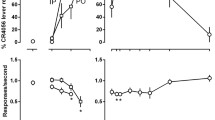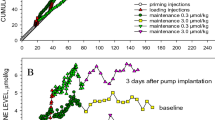Abstract
The ability of selective 5-HT3 receptor antagonists to block the discriminative stimulus effects of ethanol was investigated in pigeons trained with food reinforcement to discriminate ethanol (1.5 g/kg; IG) from water. The 5-HT3 receptor antagonists that are substituted tropines, ICS 205-930 (0.1–0.56 mg/kg) and MDL 72222 (3.0–17.0 mg/kg), blocked ethanol-appropriate responding, in a dose-dependent manner, suggesting that some of the discriminative stimulus effects of ethanol are mediated via the 5-HT3 receptor. The blockade the discriminative stimulus effects of ethanol occurred in the presence of approximately 25–40 mM blood ethanol levels. Furthermore, the ethanol dose-effect function was shifted to the right by increasing doses of MDL 72222, suggesting a surmountable antagonism of the discriminative stimulus effects of ethanol. However, the benzamide zacopride (0.56–1.7 mg/kg), which is also a 5-HT3 receptor antagonist, did not block the discriminative stimulus effects of ethanol. In addition, the dopaminergic antagonist haloperidol and the 5-HT2 receptor antagonist ketanserin also failed to block the ethanol discrimination. The results suggest that 5-HT3 mediated neurotransmission is an important component of ethanol's discriminative stimulus effects, but that the structural characteristics of the selective 5-HT3 receptor antagonists influence their ability to block this action of ethanol. Furthermore, these findings implicate a significant role of 5-HT3 activity in the behavioral effects of ethanol that may provide a pharmacological means for therapeutic intervention of alcohol abuse.
Similar content being viewed by others
References
Ator NA (1990) Drug discrimination and drug stimulus generalization with anxiolytics. Drug Dev Res 20:189–204
Bockaert J, Sebben M, Dumuis A (1990) Pharmacological characterization of 5-Hydroxytryptamine 4 (5-HT4) receptors positively coupled to adenylate cyclase in adult guinea pig hippocampal membranes: effect of substituted benzamide derivatives. Mol Pharmacol 37:408–411
Carboni E, Acquas E, Frau R, DiChiara G (1989) Differential inhibitory effects of a 5-HT3 antagonist on drug-induced stimulation of dopamine release. Eur J Pharmacol 164:515–519
Cohen ML, Bloomquist W, Gidda JS, Lacefield W (1989) Comparison of the 5-HT3 receptor antagonist properties of ICS 205-930, GR38032F and zacopride. J Pharmacol Exp Ther 248:197–201
Cohen ML, Bloomquist W, Gidda JS, Lacefield W (1990) Ly277359 maleate: a potent and selective 5-HT3 receptor antagonist without gastroprokinetic activity. J Pharmacol Exp Ther 254:350–355
Colpaert FC (1986) Drug discrimination: behavioral, pharmacological, and molecular mechanisms of discriminative drug effects. In: Goldberg SR, Stolerman IP (eds) Behavioral analysis of drug dependence. Academic Press, Orlando, pp 161–193
Costall B, Domeney AM, Naylor RJ, Tyers MB (1988a) Inhibition by 5-HT3 antagonists of hyperactivity caused by dopamine infusion into rat nucleus accumbens. Br J Pharmacol 93:194P
Costall B, Domeney AM, Hendrie CA, Kelly ME, Naylor RJ, Tyers MB (1988b) The anxiolytic activity of GR 38032F in the mouse and marmoset. Br J Pharmacol 93:195P
Derkach V, Supernant A, North RA (1989) 5-HT3 receptors are membrane ion channels. Nature 339:706–709
Deitrich RA, Dunwiddie TV, Harris RA, Erwin VG (1989) Mechanism of action of ethanol: initial central nervous system actions. Pharmacol Rev 41:849–537
DiChiara G, Imperato A (1986) Preferential stimulation of dopamine release in the nucleus accumbens by opiates, alcohol and barbiturates: studies with transcerebral dialysis in freely moving rats. Ann NY Acad Sci 473:367–374
Dumas A, Bouhelal R, Sebben M, Cory R, Bockaert J (1988) A nonclassial 5-hydroxytryptamine receptor positively coupled with adenylate cyclase in the central nervous system. Mol Pharmacol 34:880–887
Glenn B, Green S (1989) Anxiolytic profile of GR 38032F in the potentiated startle paradigm. Behav Pharmacol 1:91–94
Grant KA, Barrett JE (1989) The role of the NMDA receptor in the discriminative stimulus effects of ethanol. Alcohol Clin Exp Res 13:310
Harris CM, Lal H (1988) Central nervous system effects of the imidazodiazepine Ro 15-4513. Drug Dev Res 13:187–203
Holtzman SG (1990) Discriminative stimulus effects of drugs: relationship to potential for abuse. In: Ader MW, Cowan A (eds) Modern methods in pharmacology, vol 6, testing and evaluation of drugs of abuse. Wiley-Liss, New York, pp 193–210
Jiang LH, Ashby CR, Kasser RJ, Wang RY (1990) The effect of intraventricular administration of 5-HT3 receptor agonist 2-methylserotonin on the release of dopamine in the nucleus accumbens: an in vivo chronocoulometric study. Brain Res 156–160
Kalant H (1986) Basic pharmacology of ethanol-serotonin interactions. Clin Neuropharmacol 9:49–51
Kilpatrick GJ, Jones BJ, Tyers MB (1987) Identification and distribution of 5-HT3 receptors in rat brain using radioligand binding. Nature 330:746–748
Lovinger DM (1990) Ethanol (EtOH) potentiates ion current mediated by 5-HT3 receptors in NCB-20 cells. Alcohol Clin Exp Res 14:313
Peters JA, Lambert JJ (1989) Electrophysiology of 5-HT3 receptors in neuronal cell lines. TIPS 10:172–175
Rees DC, Balster RL (1988) Attenuation of the discriminative stimulus properties of ethanol and oxazepam, but not of pentobarbital, by Ro 15-4513 in mice. J Pharmacol Exp Ther 244:592–598
Schecter MD (1978) Stimulus properties of ethanol and depressant drugs. In: Ho BT, Richards DW III, Chute DL (eds) Drug discrimination and state dependent learning. Academic Press, London, pp 103–117
Schmidt AW, Peroutka SJ (1989) 5-Hydroxytryptamine receptor “families” FASEB J 3:2242–2249
Signs SA, Schecter MD (1988) The role of dopamine and serotonin receptors in the mediation of the ethanol interoceptive cue. Pharmacol Biochem Behav 30:55–64
Tabakoff B, Hoffman PL (1987) Biochemical pharmacology of alcohol. In: Meltzer HY (ed) Psychopharmacology: the third generation of progress. Raven Press, New York, pp 1521–1526
Tabakoff B, Anderson RA, Ritzman RF (1976) Brain acetaldehyde following ethanol administration. Biochem Pharmacol 25:1305–1309
Waeber C, Hoyer D, Palacios JM (1989) 5-Hydroxytryptamine3 receptors in the human brain: autoradiographic visualization using [3H]ICS 205–930. Neuroscience 31:393–400
Winter JC (1977) Morphine and ethanol as discriminative stimuli: absence of antagonism byp-chlorophenylalanine methyl ester, cinanserin, or BC-105. Psychopharmacology 53:159–163
Yankel JL, Jackson MB (1988) 5-HT3 receptors mediate rapid responses in cultured hippocampus and a clonal cell line. Neuron 1:615–621
Author information
Authors and Affiliations
Rights and permissions
About this article
Cite this article
Grant, K.A., Barrett, J.E. Blockade of the discriminative stimulus effects of ethanol with 5-HT3 receptor antagonists. Psychopharmacology 104, 451–456 (1991). https://doi.org/10.1007/BF02245648
Received:
Revised:
Issue Date:
DOI: https://doi.org/10.1007/BF02245648




